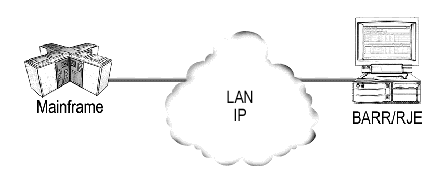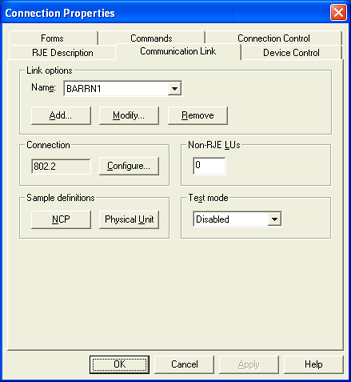
On the Communication Link tab you can specify the RJE communication protocol and physical attachment between the host system and remote computer. This topic describes the VTAM and NCP parameters you must specify in the RJE software for the communication link. These parameters must match those specified in the host VTAM and NCP parameter libraries. Your host programmer can provide the correct values to enter into the RJE software. VTAM is the mainframe program for the SNA communication protocol. NCP is the program that resides in the mainframe communications controllers.
When you finish configuring the communication links on the Communication Link tab, click NCP and Physical Unit to view sample statements the host programmer needs to enter in the host VTAM and NCP parameter libraries. The host programmer must set certain host parameters for RJE to operate. An existing remote definition used for other RJE equipment might not work with RJE. You will save time and effort getting your system running if you adhere to the recommended host definition. You can print these screens for the host programmer by clicking Print on the NCP or Physical Unit dialog box.
Physical unit (VTAM) definitions are available for HPR/IP connections.
As shown in the following graphic, HPR/IP uses any interface network card, such as Ethernet One of the LAN physical standards. It allows multiple stations to access the transmission medium. to connect to the mainframe.

HPR/IP connections connect to the mainframe using IP.
The BARR/SNA HPR/IP Link Service configuration utility and the HPR/IP Connection Configuration dialog box are used to configure the HPR/IP link service for the RJE software. The parameters specified are also used by VTAM on the mainframe. Your host programmer can provide you with the correct parameter values. After you enter the communication link parameters in the software, RJE produces a sample of the statements the host programmer needs to enter in the host VTAM parameter library. You can view and print these statements by clicking Physical Unit on the Communication Link tab.

For HPR/IP connections, you must perform additional TCP/IP and VTAM configuration.
The following is the recommended PU definition for an HPR/IP connection. You can access this dialog box by clicking Physical Unit on the Communication Link tab. The parameters that appear in the dialog box vary depending on the settings configured in the RJE software. The parameters that change are displayed in blue text.

The PU macro names and describes a physical unit.
|
puname PU |
ADDR=01, |
X |
|
|
IDBLK=03D, |
X |
|
|
IDNUM=12345, |
X |
|
|
MAXDATA=1033, |
X |
|
|
PACING=7,PASSLIM=7,VPACING=7 |
|
Required parameters
|
Parameter |
Description |
|
puname |
The PUís name conforms to the naming convention at your site. The VTAM operator uses the name to vary the unit active or inactive and to query the unitís status. |
|
ADDR=01 |
Required. |
|
IDBLK=bbb |
Parameters used on an IP network to identify the remoteís PU definition. During Xid negotiation, the remote sends an Exchange ID that contains the IDBLK and IDNUM parameters. VTAM searches for the PU identified by IDBLK and IDNUM and uses this PU for the rest of the communications session. |
|
MAXDATA=265|521|1033|2057 |
The maximum amount of data you can send on the PU in one frame. This count includes nine bytes of header information plus the data length. The default value is 1033. To maximize performance, you can increase throughput by sending larger frames of data and thus reduce the amount of control information and total number of frames sent. Send 1024 bytes by setting MAXDATA to 1033 on the HPR/IP Connection Configuration dialog box and VTAM PU definition. Setting MAXDATA to 2057 can result in greater system throughput, but it is not recommended for Ethernet or other LAN equipment that will not support the larger packet size. |
|
PACING=n |
Determines how much data the host sends to RJE before it needs a pacing response to send more data. Pacing is a flow-control mechanism that prevents the host from sending data faster than RJE can print or otherwise handle it. Values smaller than 7 often lower performance. |
|
PASSLIM=n |
The maximum number of information frames sent to the PU at one time. |
|
VPACING=n |
Similar to the PACING parameter, but VPACING determines pacing between the RJE system and VTAM. Values less than 7 lower efficiency. To maximize performance, setting parameters to larger values can improve RJE performance. With PACING=7 and VPACING=7 in the VTAM PU definition, the host can send 7 data frames before it requires a pacing response. On a half-duplex line, it sends 7 frames at a time. When you use PACING=7, the pacing response could be returned in time to send 7 more frames of data. |
System default values
|
Parameter |
Description |
|
DISCNT=(NO,F) |
Does not disconnect the PU until requested by RJE. |
|
ISTATUS=ACTIVE |
Automatically activates the PU. |
|
PUTYPE=2 |
RJE uses the Physical Unit Type 2 protocol. |
Other useful parameters
|
Parameter |
Description |
|
DLOGMOD=nnnnnnnn |
Names the logon mode table entry to use by default. |
|
MODETAB=nnnnnnnn |
Specifies the mode table containing the logmode entries. ISTINCLM is the default IBM-supplied mode table usually present with VTAM. |
|
SSCPFM=USSSCS |
If this parameter is set, then the host's logon type and the Logon type selected on the RJE Description tab, must be configured as Character Coded. The system default is SSCPFM=FSS, which indicates that the Logon type must be Formatted. |
The LU macro instructions define LUs allocated to the RJE devices.
|
luname02 LU |
LOCADDR=2, |
** RJE LU |
|
luname03 LU |
LOCADDR=3, |
** RJE LU |
|
luname04 LU |
LOCADDR=4, |
** RJE LU |
|
luname05 LU |
LOCADDR=5, |
** RJE LU |
|
luname06 LU |
LOCADDR=6, |
** RJE LU |
Use the LU macro formula to calculate the number of LUs you need.
Required parameters
|
Parameter |
Description |
|
lunamenn |
The LU name conforms to the naming convention at your site. RJE does not use this name. |
|
LOCADDR=i |
The local addresses must be unique. The maximum value for i is 20 when you use Barr software. MVS/JES2 supports a maximum of 13 LUs with RJE. |